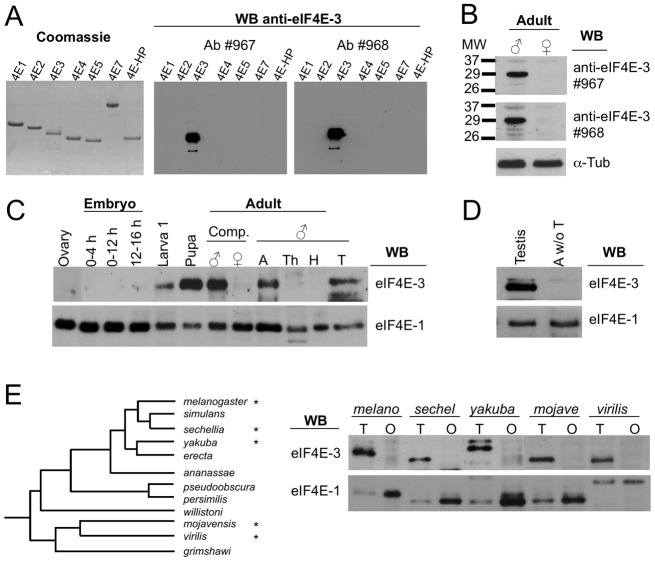Fig. 1.
eIF4E-3 is a testis-specific protein. (A) Generation of two specific antibodies (#967 and #968) against Drosophila eIF4E-3. (Left) Recombinant Drosophila eIF4Es and 4E-HP proteins (2 μg per lane) were resolved by SDS-PAGE and stained with Coomassie Blue. (Center and right) Western blotting of recombinant eIF4Es (0.2 μg/lane) shows that antibodies #967 and #968 specifically recognize eIF4E-3. (B) Western blot (WB) of total extract (20 μg per lane) from whole wild-type males or females with the indicated antibodies. α-Tubulin provided a loading control. (C,D) Developmental expression of eIF4E-3 and eIF4E-1 as analyzed by western blotting. Total protein extracts (20 μg per lane) prepared from the indicated developmental stages were probed. In all cases western blotting with the respective preimmune sera did not recognize any band (data not shown). (C) Lane 1, ovary; lanes 2-4, embryo lysates from the indicated ages; lane 5, first instar larvae stage; lane 6, pupae; lane 7, whole adult males; lane 8, whole adult females; lanes 9-12, adult males: A, abdomen; Th, thorax; H, head; T, testes. (D) Western blots of adult testes and abdomen without testes (A w/o T). (E) Expression of eIF4Es in gonads across Drosophila species. (Left) Phylogenetic tree of the 12 sequenced species (Clark et al., 2007); species that were analyzed are marked with asterisks. (Right) Western blotting (20 μg/lane) of total lysates form adult testis (T) and ovary (O) from D. melanogaster (melano), D. sechellia (sechel), D. yakuba (yakuba), D. mojavensis (mojave), and D. virilis (virilis) were probed for the indicated proteins. Note that the sexually dimorphic expression of eIF4E-3 (restricted to testis) and eIF4E-1 (in both tissues, but more abundant in the ovary) is conserved across the genus Drosophila.

